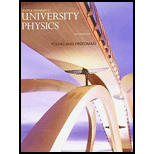
Concept explainers
CALC It is possible to calculate the intensity in the single-slit Fraunhofer diffraction pattern without using the phasor method of Section 36.3. Let y′ represent the position of a point within the slit of width a in Fig. 36.5a, with y′ = 0 at the center of the slit so that the slit extends from y′ = −a/2 to y′ − a/ 2. We imagine dividing the slit up into infinitesimal strips of width d y′ each of which acts as a source of secondary wavelets, (a) The amplitude of the total wave at the point O on the distant screen in Fig. 36.5a is E0. Explain why the amplitude of the wavelet from each infinitesimal strip within the slit is E0(dy′/a), so that the electric field of the wavelet a distance x from the infinitesimal strip is dE = E0(dy′/a) sin (kx – ωt). (b) Explain why the wavelet from each strip as detected at point P in Fig. 36.5a can be expressed as
Where D is the distance from the center of the slit to point P and k =2πλ.. (c) By integrating the contributions dE from all parts of the slit, show that the total wave detected at point P is
(The trigonometric identities in Appendix B will be useful.) Show that at θ = 0°, corresponding to point O in Fig. 36.5a, the wave is E = E0 sin(kD − ωt) and has amplitude E0, as stated in part (a), (d) Use the result of part (c) to show that if the intensity at point O is I0, then the intensity at a point P is given by Eq. (36.7).
Want to see the full answer?
Check out a sample textbook solution
Chapter 36 Solutions
University Physics (14th Edition)
Additional Science Textbook Solutions
Campbell Biology in Focus (2nd Edition)
Chemistry: Structure and Properties (2nd Edition)
Microbiology with Diseases by Body System (5th Edition)
Chemistry: An Introduction to General, Organic, and Biological Chemistry (13th Edition)
College Physics: A Strategic Approach (3rd Edition)
Genetic Analysis: An Integrated Approach (3rd Edition)
- Lab 8 Part 3 PHET Wave Interface simulation. I am having trouble with this part of the lab.arrow_forwardMick and Rick are twins born on Earth in the year 2175. Rick grows up to be an Earth-bound robotics technician while Mick becomes an intergalactic astronaut. Mick leaves the Earth on his first space mission in the year 2200 and travels, according to his clock, for 10 years at a speed of 0.75c. Unfortunately, at this point in his journey, the structure of his ship undergoes mechanical breakdown and the ship explodes. How old is Rick when his brother dies?arrow_forwardHi, I have canceled, why did you charge me again?arrow_forward
 Physics for Scientists and Engineers: Foundations...PhysicsISBN:9781133939146Author:Katz, Debora M.Publisher:Cengage Learning
Physics for Scientists and Engineers: Foundations...PhysicsISBN:9781133939146Author:Katz, Debora M.Publisher:Cengage Learning Principles of Physics: A Calculus-Based TextPhysicsISBN:9781133104261Author:Raymond A. Serway, John W. JewettPublisher:Cengage Learning
Principles of Physics: A Calculus-Based TextPhysicsISBN:9781133104261Author:Raymond A. Serway, John W. JewettPublisher:Cengage Learning Glencoe Physics: Principles and Problems, Student...PhysicsISBN:9780078807213Author:Paul W. ZitzewitzPublisher:Glencoe/McGraw-Hill
Glencoe Physics: Principles and Problems, Student...PhysicsISBN:9780078807213Author:Paul W. ZitzewitzPublisher:Glencoe/McGraw-Hill College PhysicsPhysicsISBN:9781285737027Author:Raymond A. Serway, Chris VuillePublisher:Cengage Learning
College PhysicsPhysicsISBN:9781285737027Author:Raymond A. Serway, Chris VuillePublisher:Cengage Learning University Physics Volume 3PhysicsISBN:9781938168185Author:William Moebs, Jeff SannyPublisher:OpenStax
University Physics Volume 3PhysicsISBN:9781938168185Author:William Moebs, Jeff SannyPublisher:OpenStax Physics for Scientists and Engineers, Technology ...PhysicsISBN:9781305116399Author:Raymond A. Serway, John W. JewettPublisher:Cengage Learning
Physics for Scientists and Engineers, Technology ...PhysicsISBN:9781305116399Author:Raymond A. Serway, John W. JewettPublisher:Cengage Learning





